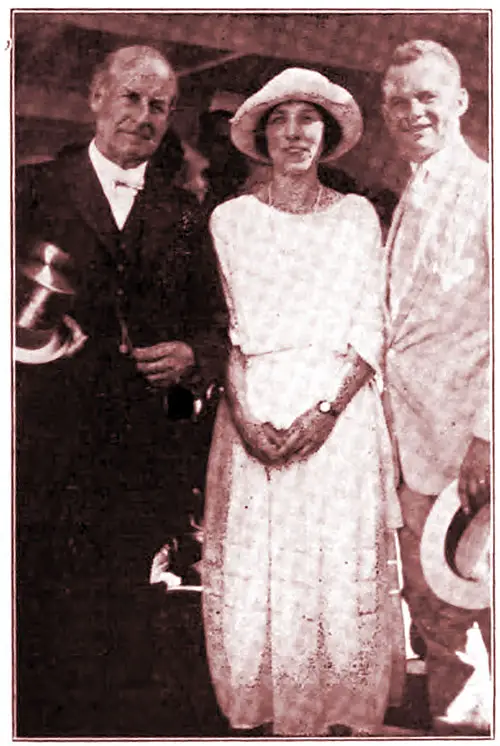A Wedding on Shipboard - 1923
Mr. and Mrs. G. J. Huber, Bride and Groom, With the Hon. W. J. Bryan, Who "Gave Away" the Bride.—Photo Loaned by Toledo Metal Furniture Company. | GGA Image ID # 160345ab90
A schoolday romance reached a happy culmination on Saturday evening, 11 November 1922, on the good ship "Ecuador," when Godfrey John Huber, a prominent member of the American colony at San Salvador, was married to Miss Helen Dickerson Hitch. The wedding was solemnized between San Jose, Guatemala, and La Libertad on the high seas.
The ceremony took place in the steamer's main dining room. The room was beautifully and appropriately decorated for the occasion, and all the passengers competed with each other to suggest novel and ingenious features. Captain Thomas Fleming officiated, and although this was the first marriage ceremony he had ever been called upon to perform, he handled the affair with grace, dignity, and solemnity.
Miss Harriet Hollingshead of Chicago accompanied Miss Hitch from the United States and acted as bridesmaid. R. J. Sharp acted as best man. The bride was "given away" by the Hon. William Jennings Bryan, who knew the bride and groom's fathers and happened to be a passenger on the boat.
Colonel Bryan entered with zest into the spirit of the occasion and, in congratulating the newlyweds, expressed the hope that the union would be as fruitful of happiness as that of Mrs. Bryan and himself had been.
Colonel Bryan and the Hon. Boas W. Long, formerly United States minister to Salvador, signed the ship's log as witnesses to the marriage.
All of the officers and passengers of the "Ecuador" were guests at the wedding, and after the ceremony, they celebrated the event and "Armistice Night" with a merry party that continued until early morning.
Colonel Bryan facetiously announced that if any other young couples on board contemplated getting married, he and Captain Fleming were ready to do their part toward helping them on their way.
The groom is a son of Dr. and Mrs. Charles Huber of Cincinnati, O., and a partner in the firm of E. E. Huber & Co., San Salvador and Tegucigalpa, who represent American office furniture and other lines.
The bride is the daughter of Mr. and Mrs. H. G. Hitch of Terre Haute, Indiana.
The young couple spent their honeymoon at Lake Coatepeque. They returned to San Salvador on 1 December, where they will make their home.
"A Wedding on Shipboard," in Office Appliances, January 1923, p. 135.
A Wedding on Shipboard - 1923: A Review and Its Relevance to Ocean Travel
The article "A Wedding on Shipboard" (1923) presents a charming and historically significant account of a shipboard wedding that took place on the S.S. Ecuador on November 11, 1922, between Godfrey John Huber and Helen Dickerson Hitch.
The event was officiated by Captain Thomas Fleming, witnessed by William Jennings Bryan, a former U.S. Secretary of State, and attended by passengers and crew alike. This unique celebration, occurring on the high seas between San Jose, Guatemala, and La Libertad, El Salvador, serves as an insightful glimpse into maritime traditions, the social dynamics of early 20th-century ocean travel, and the role of ship captains in officiating marriages.
Relevance to Various Fields of Study:
1. For Teachers & Students:
- This article offers an engaging case study of marriage customs at sea, allowing students to explore how maritime law intersected with social traditions.
- It provides context for discussions on early 20th-century ocean travel, including shipboard culture and passenger experiences.
- The involvement of William Jennings Bryan, a key historical figure, connects this wedding to American political and diplomatic history.
2. For Genealogists:
- Shipboard weddings, such as this one, highlight unusual locations for marriage records, which may be vital for individuals tracing family histories.
- The inclusion of witnesses’ names and family backgrounds provides genealogists with additional sources of lineage verification.
- This account demonstrates how American citizens, particularly those working abroad, might have documented their marriages through ship logs rather than civil or religious institutions.
3. For Historians:
- The article captures the romantic and celebratory aspects of ocean travel during the Golden Age of Steamship Travel, showcasing social interactions on long voyages.
- The presence of William Jennings Bryan, a well-known political and oratorical figure, adds a layer of historical significance, reflecting elite passengers’ involvement in maritime culture.
- The officiation of a marriage by a ship captain provides insight into maritime law practices, particularly the authority given to captains in the absence of religious or civil officials.
4. For Maritime and Social History Enthusiasts:
- The decorated dining hall, participation of fellow passengers, and extended celebration into the night illustrate the communal spirit of transoceanic voyages.
- The event’s combination with Armistice Day celebrations demonstrates how shipboard life incorporated national events and commemorations into the social fabric of travel.
- The honeymoon destination, Lake Coatepeque, reflects how maritime travel connected to broader tourism and expatriate experiences in Latin America.
Key Highlights of the Event:
- First-Time Officiation: Captain Thomas Fleming officiated his first-ever wedding.
- High-Profile Witnesses: William Jennings Bryan, a former U.S. presidential candidate and Secretary of State, played a ceremonial role in “giving away” the bride.
- Shipboard Festivities: The entire ship, including passengers and crew, celebrated the wedding alongside Armistice Night commemorations.
- International Social Circles: The groom was a businessman from San Salvador, and the bride hailed from Terre Haute, Indiana, showcasing the global connections of steamship passengers.
Conclusion
"A Wedding on Shipboard" (1923) provides a rich and vibrant account of an early 20th-century shipboard marriage, highlighting the romantic, legal, and social dimensions of ocean travel. This article is an excellent resource for those studying maritime history, genealogy, and early travel experiences, illustrating how ocean liners functioned as more than just transportation vessels but as floating communities where significant life events took place.

